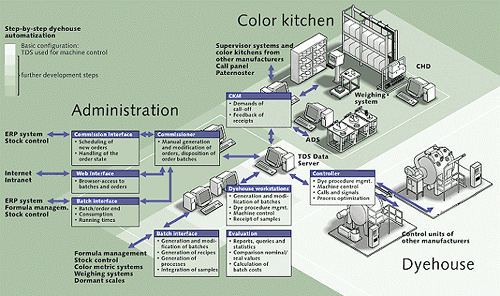In today's competetive world it has become very
important for a dye house to have a thoroughly consistent system. This
development is an absolute necessity now for improving quality and fast
turn arounds. Without the proper integration of dyeing equipment into a
sound organized network, it is quite obvious that the dyehouses can give
away its valuable resources very cheaply.
A fully integrated dye house network comprises of a vast range of
automated system components properly syncronized to each other. Machines
that are capable of performing a number of operations like dyeing, heat
setting, compacting, stentering, hydro-extraction, brushing and washing
etc. A typical Dye house network functions like this. It supplies the
dyeing machines with dyestuff, chemicals and along with it if the need
be, hot water. Another vital task is the control of the system. Although
every single device from the color kitchen to dyeing machines these days
are PC-controlled, however modern dye houses prefer to employ a Dyehouse
automation system. This system ensures that the machines are able to
synchronize with each other and can optimise their capacities. Apart
from this the automation system facilitates linking of the order
management with the necessary machine control units. This helps to
complete a fully integrated dyehouse network. The diagram that follows
next gives a perfect example of Dye house that is complete in every
respect. Most modern dye houses are today following the concept of
totally networked Dye House.
If the dyehouse does not meet with the following
criteria, then perhaps it is necessary to rethink and go in for a new
dye house:
 Quality-
Quality-
In today's fiercely competetive market, if a manufacturer doesn't
have a consistent quality, probably they just can't stay put in
business. Therefore a manufacturer must insist on receiving only quality
and genuine products from suppliers. Infact adhering to different
International quality standards that has written down procedures and
manuals is now more than just a norm. There are now various information
technology companies that are into the field of operations management.
If they are called for and allowed to work on a program at a dye house
and follows up it through the completion, then a dye house will be
equipped with a totally integrated data base system. This will offer
solutions in every sphere of operations like manufacturing, production,
financial, forecasting, planning, scheduling and delivery.
 Challenges
of globalisation-
Challenges
of globalisation- Over the years the supply of material has
changed. Today suppliers are challenged from across globe with products
of superior quality, and low cost. For example yarn suppliers continues
to search for non-branded suppliers of polyester and acrylic for
replacing more costlier brand names. Today's mantra is innovate or
perish.
 Savings
in energy-
Savings
in energy- Saving in energy, chemicals and water is now vital for
survival of any dye house. Machine vendors are now constantly
redesigning dye machines that has the lowest liquid to goods ratio. For
example a high pressure dyeing machine consumes much less water for
processing. The liquid to goods ratio being 1:5 (i.e. to process 1
kilogram of fabric, five litres of water are used) now compare this to
traditional units that are fitted with conventional winches whose water
to liquid ratio is in the range of 1:15 or even sometimes 1:20. Survival
for such dye houses is impossible.
 Package
preparation-
Package
preparation- To be succeesful, dyers must go for latest stainless
steel spacer for holding the shape of package ends. This allows for
smooth unwinding. Though backwinding to paper cones along with
intermediate lubrication is more in vogue, but that costs money and
time. Dyers must master new ways to bypass the idea of backwinding.

 Package
handling-
Package
handling- Increasingly the dye houses are insisting on the
technology of robotic package handling. Use of Robotics demands
uniformity. Robots need the packages to be placed in a specific
location.
 Modern
laboratories-
Modern
laboratories- New formulas are first dyed in the lab before it is
implemented in production. If there is closer liquor ratio agreement
between the production and laboratory, better would be the final result.
 Maintenance-
Maintenance-It
is a general tendency to view maintenance time as an opportunity lost to
manufacture dyed sales yarn. Preventive maintenance is clearly less
expensive than unscheduled halt and a spoiled dyeing.
 Computer
aided Dyeing system-
Computer
aided Dyeing system- By implementing a Computer aided Dyeing system
it has been possible to cut down on both costs and time. For example it
has been found that by using the system there has been reduction in the
acrylic dyeing batch time by at least 30 percent.








